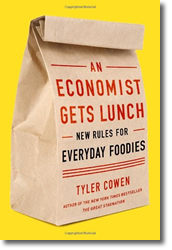
Cowen, Tyler. An economist gets lunch : new rules for everyday foodies. Dutton, 2012.
The words “everyday foodies” in the title of Tyler Cowen’s book were what first attracted my interest. Even though I plead guilty to being a “foodie”, I cringe a bit inside when I write or say it. The word has an elitist whiff to it.
An “everyday foodie” sounds more down-to-earth and approachable; and much of An Economist Gets Lunch focuses on distinguishing the behaviors of the everyday foodie from those of the food snob and the thoughtless consumer. Cowen does readers and mindful eaters a great service by explaining both the positive and negative effects of America’s food supply chain. He also provides guidelines to help the reader make every meal count, realize that good food is often cheap food, and to be innovative as consumers.
If you’ll pardon the pun, the meat of An Economist Gets Lunch begins in Chapter 7 (“Another Agricultural Revolution, Now”). Cowen starts with the revelation that corn as we now know it is the product of progressive genetic engineering, i.e. selective breeding, practiced over millennia by farmers in central Mexico. It was the first “Green Revolution”.
This will probably surprise readers who reflexively refer to modern day genetically modified grains as “Frankenfood”. Cowen’s passionate and well-reasoned defense of GMOs (genetically modified organisms) later in the chapter is foreshadowed by his description of the third Green Revolution — the adaptation of American agricultural technologies for practical use in poorer countries to improve crop yields and dramatically reduce deaths from hunger. According to Cowen, these benefits of technological progress and agricultural commercialization demonstrate that “the agribusiness platform … the food infrastructure of the modern world, is one to build upon and improve, rather than throw away.”
It may sound as if the author is a full-throated supporter of Big Agribusiness; but his arguments for carbon taxes set by governments to modify consumer behavior makes it clear that this is not the case. It is ironic that Cowen spends many pages empowering consumers to make intelligent, thoughtful choices about how and what they eat; yet he concludes here that it would be just too difficult for consumers to accurately make choices about what foods are the most or least “green”.
Another irony, really a self-contradiction, is Cowen’s suggestion to “minimize the number of car trips” required to support food consumption; and yet throughout the book, he emphasizes the value of increased travel as critical to the education and experience of the everyday foodie.
An Economist Gets Lunch is an interesting and informative read in that it opens readers’ eyes to the currently under-reported benefits of our US food supply chain, and the humanitarian value of GMO food crops. But the “food advice” chapters progressively read like lightly edited blog posts, and assume readers will have access to a metropolitan setting like the author’s. Cowen’s generalizations about locavores — “those who eat local foods, either mostly or exclusively” as being driven by a desire for “a feel-good attitude” are also too sweeping, and slightly hypocritical, in this reviewer’s opinion, given Cowen’s high praise for local foods in other countries.
An Economist Gets Lunch is recommended, like a good restaurant, with reservations.
© Reviewer: Carlton Brown & Ford Library – Fuqua School of Business.
All rights reserved.


